Defining the Pro in Apple Vision Pro: Who is Apple's target professional?
The Apple Vision Pro is an excellent media consumption tool. Still, in our experience and after talking to enterprise, the US federal government, and tradespeople, it's not close to where it needs to be for wide adoption in business.
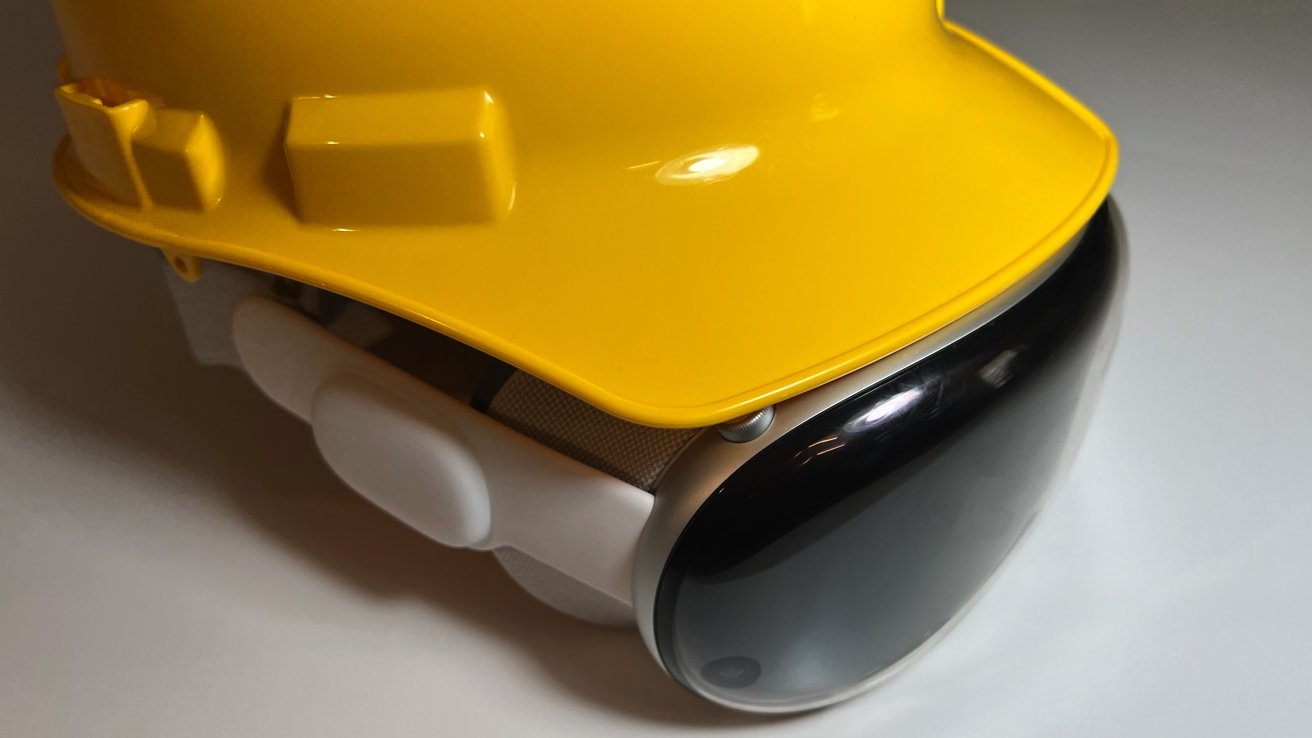
Apple Vision Pro for business: hardhat optional
We're past the point where we need to lay out the specs of the Apple Vision Pro in this review. It's clearly an attractive product, as VR headsets masquerading as AR headsets go, and it has packed a lot of technology into the device.
It's a great movie-watching device, there are burgeoning gaming options on it, even outside of the App Store. The (very few) interactive content showcases that there have been are presented well and put together excellently.
If you must know about the technology, Wes Hilliard has put together an excellent review for the consumer or prosumer looking at the headset and why they should buy it. Go read that first for a primer, if you need to.
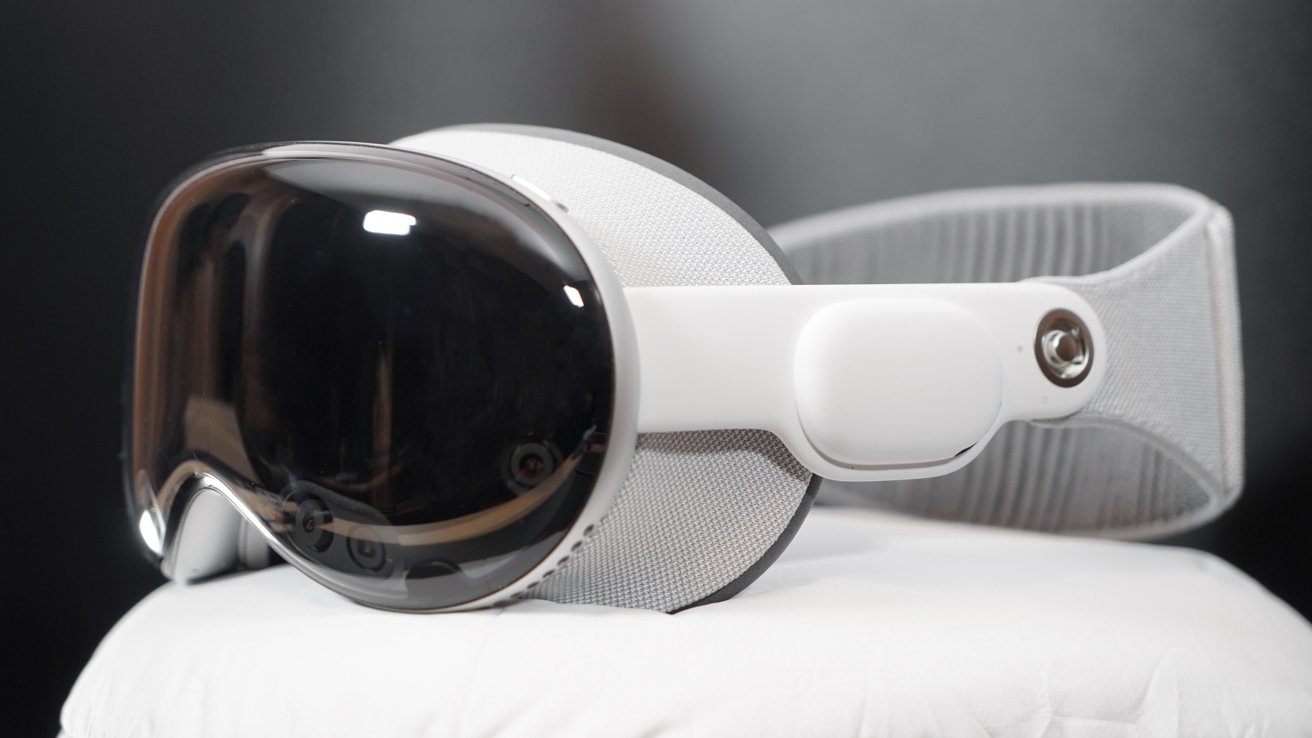
Apple Vision Pro review for business: Apple Vision Pro on the too-expensive Apple bag
What's been talked about less is businesses, the feds, and trade workers' resistance to and successes from it.
Fortunately, I know a lot of people in those fields. Many of them are the same people who have helped us review the highest-end Mac hardware.
Apple Vision Pro in the workplace
Apple dropped Apple Vision Pro on the world at WWDC 2023, saying it was coming in early 2023. Despite the prevailing wisdom that Apple would ship about six of them in the last week of June to meet this deadline, the company crushed that deadline with an early February shipment.
But in between, Apple didn't say much at all. To anybody. The company shipped developer's kits to some and held sessions for others. For Apple's own inscrutable reason, it didn't do a lot more.
There wasn't much outreach to enterprise, where there had been before with other product launches. The federal government employees we spoke to who historically have had a good back-and-forth with Apple said they actively reached out but were silent.
And then January 2024 came.
Suddenly, there were executive interviews here and there, talking about how excited they were to get the headset in the hands of businesses and so forth. As we've been told, this was met with some incredulity behind closed doors, given the lack of detail that they were provided between the debut and shipment announcement.
We're sure that Microsoft got everything they needed, and we're equally certain that had Google given a single damn about the product, Apple would have bent over backward to help them too.
So, expectations outside Cupertino in enterprise and so forth were low from the start. That may be good, but there is an undercurrent of bitterness in some of the people we spoke to who are responsible for implementation and assessment.
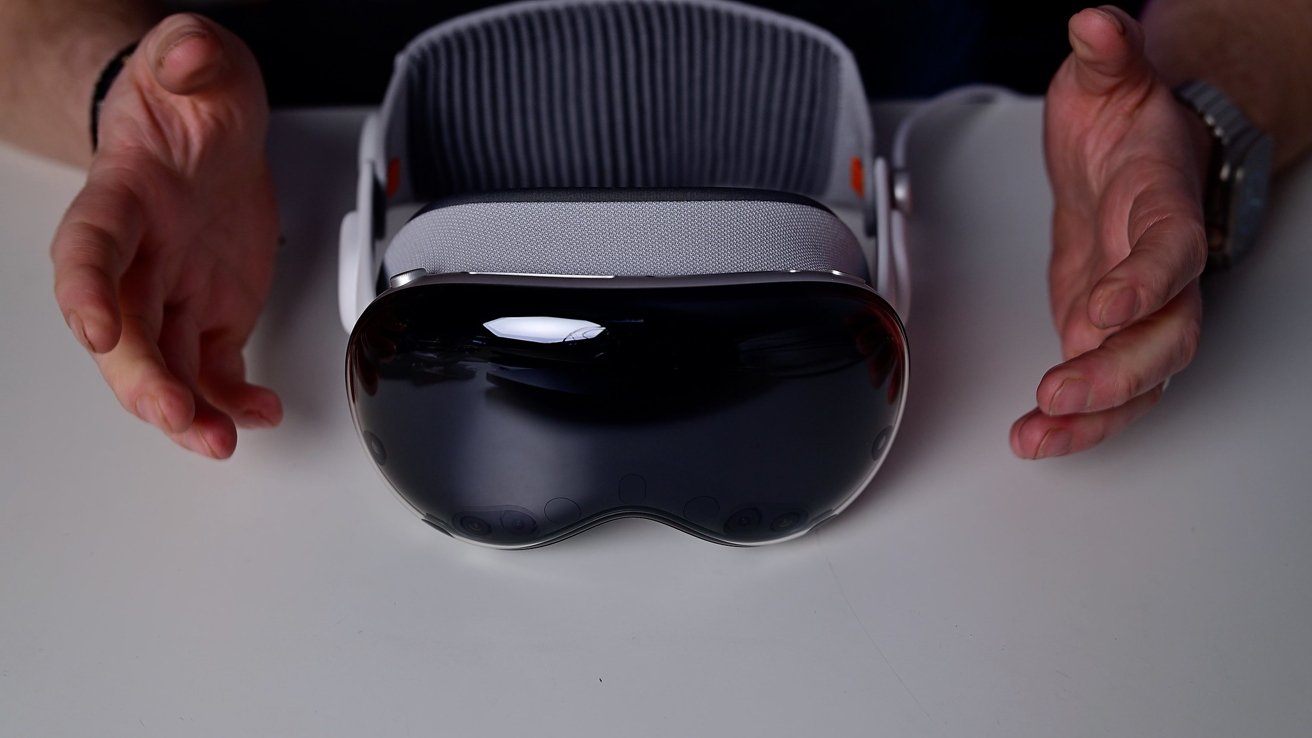
Apple Vision Pro review for business: the headset
The folks that are excited about Apple Vision Pro see a future where operating procedures for maintenance or a task can be provided to a worker in real time. Alternatively, installation instructions and contextual information are possible, as are contextual safety exhortations to a user or audio instructions sent from a supervisor, limited to a single worker's ears.
Apple Vision Pro could also provide a company's workers in the field actual and relevant information to a custom installation in real-time, like a service history, instead of knowledge passed down verbally and perhaps not remembered well.
All of this is possible with Apple Vision Pro. The practicality of doing this today is another matter entirely.
Apple Vision Pro pricing for enterprise is the first speed bump
The Apple Vision Pro is expensive. It's loaded with sensors, optical glass, lenses, emitters, and, most expensively, screens.
At the same time, this isn't an Xbox. It's not a loss leader to get people to buy into software. There's a profit being made on it, but it's just not clear how much.
There haven't been any serious bill of materials breakdowns yet, but they're inevitable. And, besides making guesses on what things cost from a material standpoint, they never cover the cost of research, labor, and more, so they're never the final word.
The deals Apple makes through its enterprise sales channels are its own business, and squeezing data out of folks about them is hard. Apple advertises some educational pricing like on Mac mini and iPad, but don't be fooled -- when the sale volumes get ridiculous, and the add-on services like AppleCare are added on, Apple is not shy about steeply cutting the price of most of its hardware (compare prices on Apple hardware in our Price Guide).
Meta does this, too. They have their own enterprise sales team for Oculus hardware sales and evangelism departments to try to spread the good word of head-mounted surveillance capitalism.
For now, though, Apple isn't offering much of a discount on Apple Vision Pro headsets, regardless of volume. We've been told about enterprise sales packages with hardware discounts that don't even cover the cost of AppleCare -- which is a typical discount -- and more or less required for enterprise deals.
Right now, this is a bit of an obstacle for enterprise purchasers, and it's unclear if this will change any time soon.
Shared device profiles need to exist
It's practical for smaller teams to buy a handful of devices with a one-to-one ratio of devices to users. Getting into the hundreds of employees -- or thousands -- gets less practical from a financial standpoint very quickly.
Apple does allow some of its devices to have shared user profiles. There's obviously the Mac. You can do it on iPad too, with educational or enterprise mobile device management solutions, on basically any iPad made in the last seven years.
This doesn't exist yet for Apple Vision Pro. I'm not certain that it will, given the way that the light seal and fabric parts of the Apple Vision Pro work today.
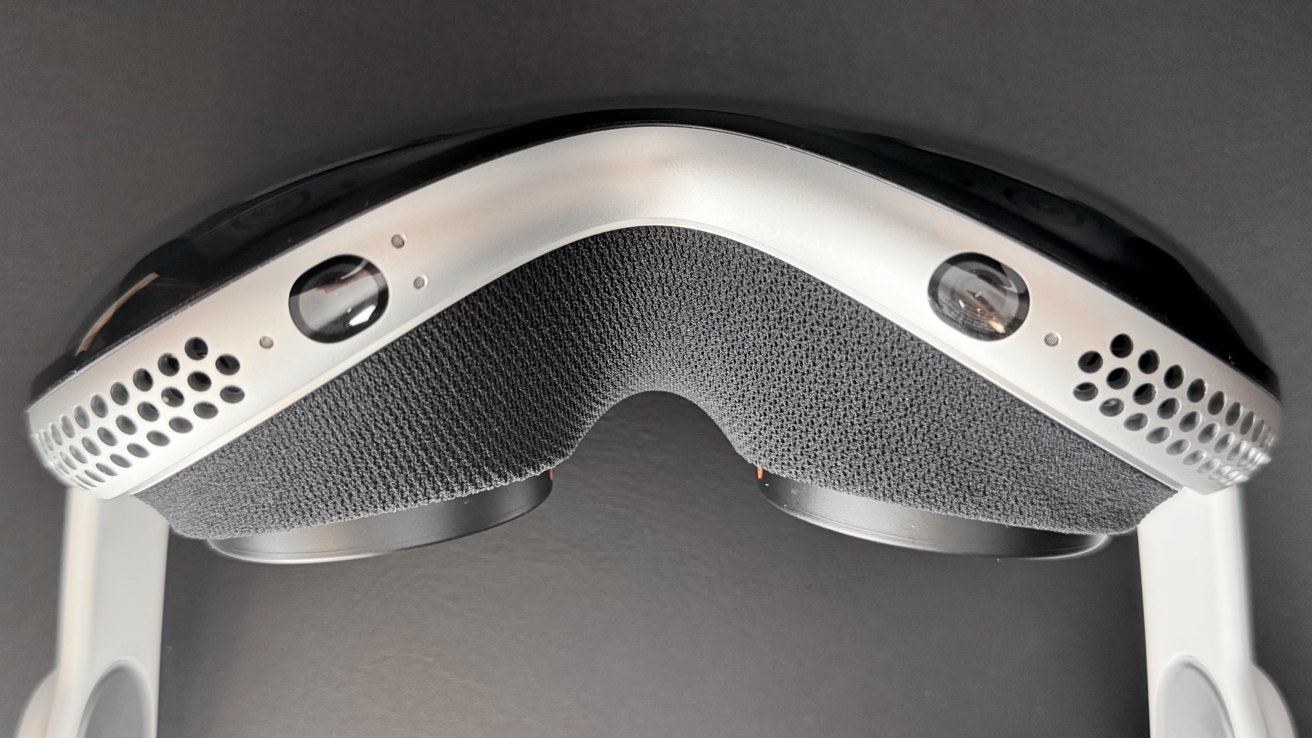 Apple Vision Pro review for business - The headset, minus the light filter cushion
Apple Vision Pro review for business - The headset, minus the light filter cushion
For a "fleet" of devices, in this case, you'd also have to have some kind of cleanliness solution for the fabric parts, which doesn't exist yet. More cleanable materials are less porous by nature, which negatively affects long-duration wearability comfort.
We expect a solution here in the longer term as Apple figures out how to make glasses that do the same thing in a form factor that does not resemble ski goggles. But, it's a problem for adoption now, just the same.
These devices cost $3500 each. Some kind of shared device system needs to exist, we've been told by literally every representative of enterprise, government, or trade work we spoke to.
The tethered battery isn't a big deal
At a glance, the external battery seems like it's not a great idea. But, in my actual home use, it hasn't been a hamper at all.
And, everybody that we've spoken to for the purposes of this review held the same opinion about the battery that I have.
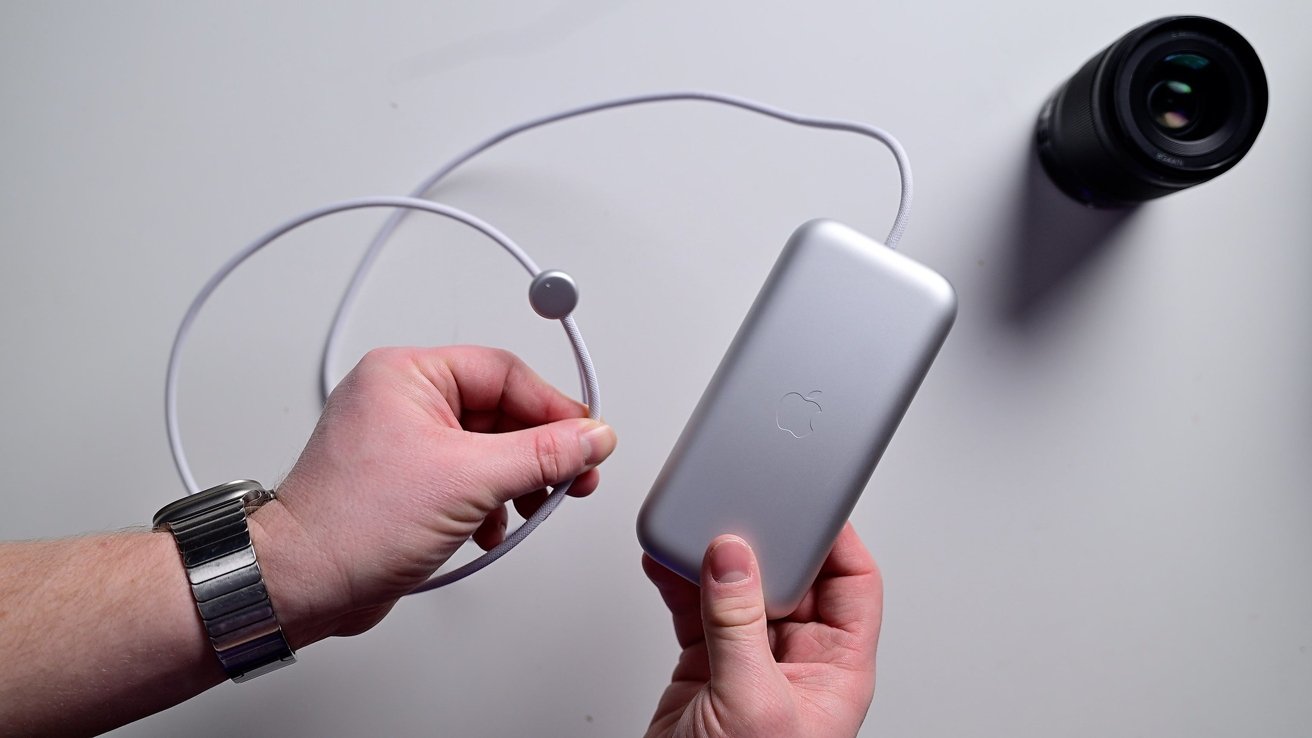
Apple Vision Pro review for business: Battery, detached
Some reviewers are getting an extra half-hour from that battery versus what Apple claims it will deliver. I haven't seen that personally or in the business use cases I've had the privilege to witness. And, the evolutions in question are not that long, clocking in at about an hour.
I'd prefer a brief period of a minute or two where the attached battery can be swapped without dropping power to the headset, but it isn't a deal-breaker.
Obviously, opinions may vary -- but in this aspect of use, the external battery doesn't seem to matter. Beyond USB-C, we expect third-party options for that battery pretty soon.
Apple Vision Pro at the desk
It's not all about industry, construction, or defense. We've also spoken to some businesses more on the white collar side of the fence.
None were that impressed by what it brings, with most of them commenting that it doesn't do anything better versus what they're doing now, and how they're doing it.
Mac monitor mirroring performs well in my own testing. A single large canvas seems interesting, but that's the crux -- a single canvas.
Multiple displays are proven productivity enhancers in the office. Even an external display connected to a single laptop helps a great deal. The Apple Vision Pro adds weight and an extra component to the existing office setups, in an imperfect single-screen mirroring environment.
And, all the aspects about the lack of ability to share Apple Vision Pro that we spoke about earlier apply to the office as well. Office computer users aren't known for having beefy computers, so adding a $3500 headset to a $600 computer and monitor setup, or a $1100 iMac makes very little sense in this environment.
The hardware just doesn't even answer a question that hasn't been asked. It's just something on top of what already exists, adding an additional complexity layer.
And then, there's the travel mode.
Right now, travel mode works poorly on the plane and not at all on the train
Common to enterprise, white collar, and federal service is travel. Apple Vision Pro, as it stands with visionOS 1.0.3, needs a travel mode that works better.
It's acceptable on the plane -- as long as you don't look outside, ever. Whatever the reason, the system breaks down, and your windows slide away, locked in space.
This is contrary to how this is supposed to work, and we think this will get fixed. The short-term solution is to not look outside.
A train or a car is a much more challenging environment for travel mode. The windows are larger, and it is almost guaranteed the Apple Vision Pro sensors will see movement through those windows, and react accordingly.
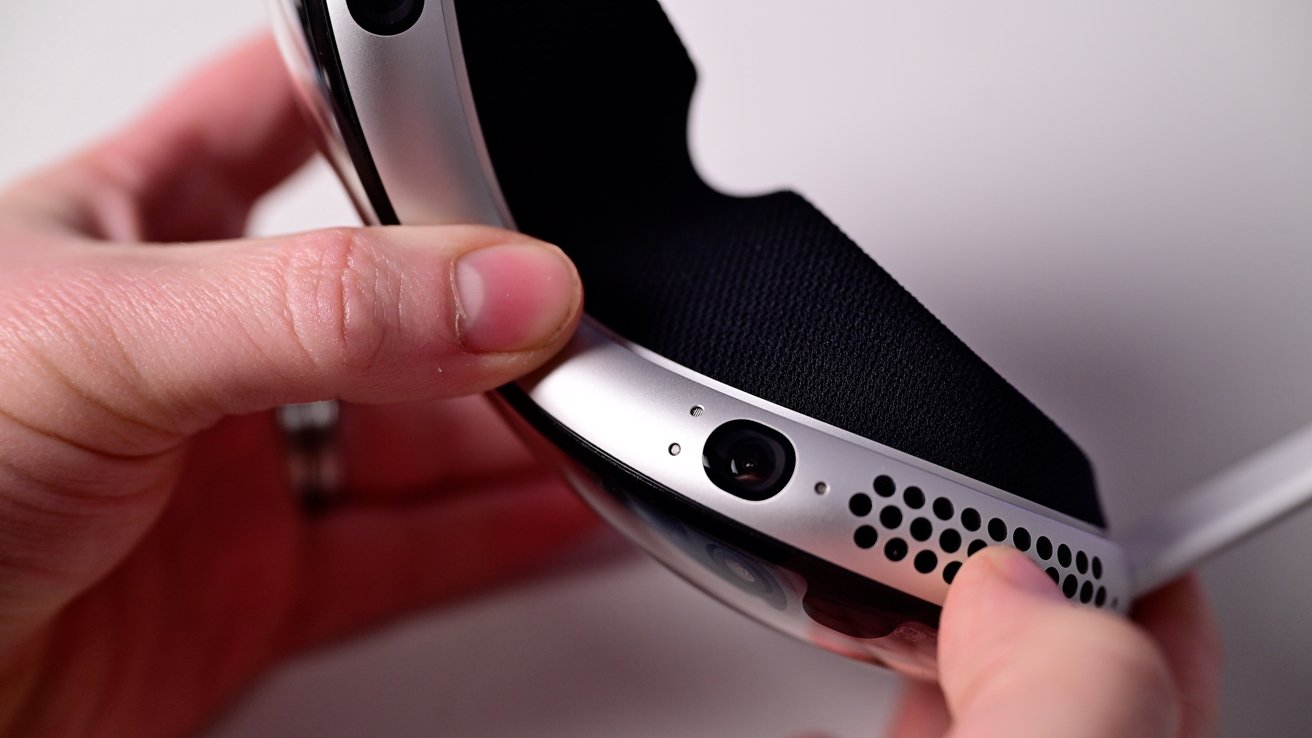
Apple Vision Pro review for business: Optical hand sensor close-up
With all this said, and strangely related, Apple Vision Pro seems very reliant on visual sensing of hand location. If you put the device in travel mode, it relies on the optical sensors less and more on infrared.
So, pro tip: turn travel mode on if you use the Apple Vision Pro in bed or a dark room. Gesture use and hand tracking is much better if you do.
Comfort and safety in the workplace
There's been an adage in the industry forever that safety may be job one, but comfort is most important. It's self-defeating, but we've seen folks not wear eye or hearing protection because it just wasn't comfortable enough or somehow got in the way of the job.
Most got lucky. Obviously, some did not, and not wearing safety gear is typically only a lesson you need to learn once.
Apple Vision Pro and similar headsets aren't safety devices in any way, so that's one strike. And they're not very comfortable outside the office either, which is strike two.
"You get sweaty working already, and all-round eye protection has a sweat all its own," one technology executive at a large commercial construction company told me.
It's not just in construction that environmental concerns are being thought about, as it pertains to Apple Vision Pro.
"Apple Vision Pro is sweaty in an office chair, let alone when it's 90 near the main engines, with 70 percent humidity and you're contorting around pipes in an engine room," a civilian employee in the Department of Defense also told me.
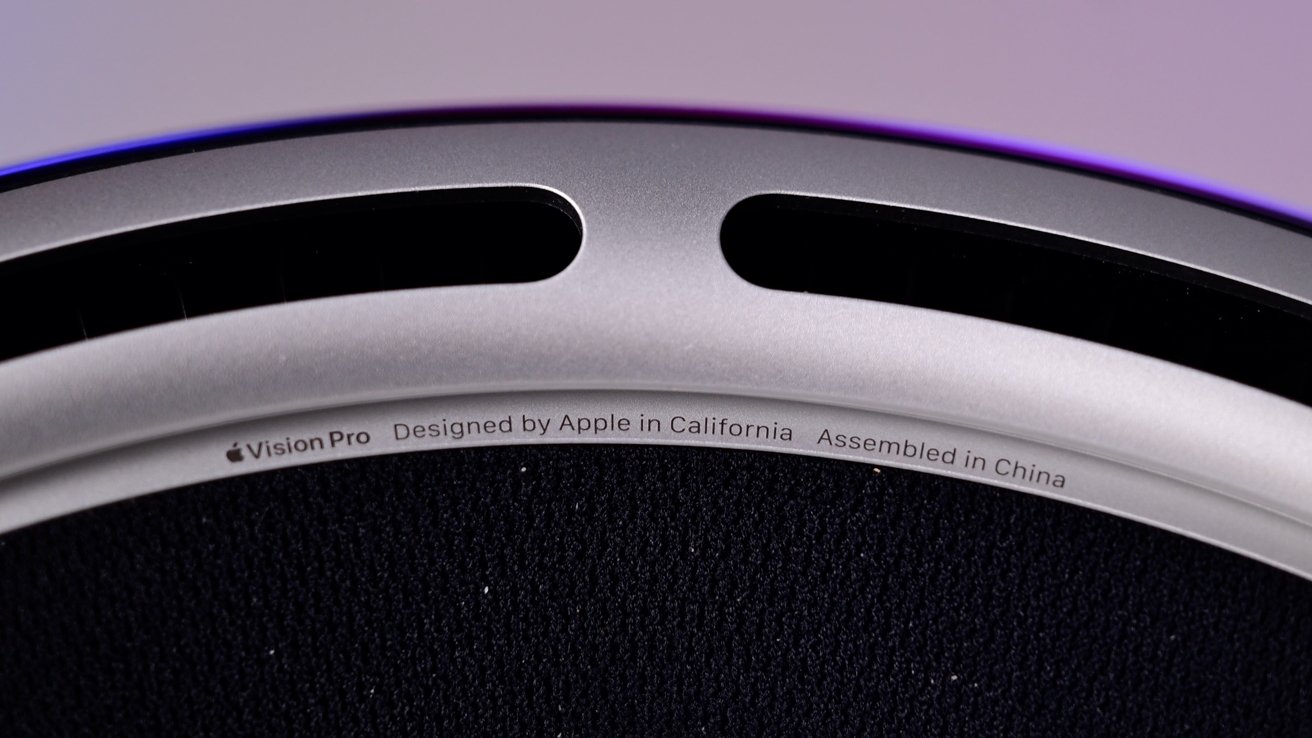
Apple Vision Pro review for business: vents underneath the headset
In a laboratory that requires eye protection from chemical exposure, the Apple Vision Pro isn't a great choice either. That fan that helps with user comfort and electronics heat will draw fumes and particulates right across the user's eyes.
In an evaluation performed by some tradespeople with the product, the Apple Vision Pro is not fully covered by a standard hard hat brim. It doesn't protrude much, but there is about a quarter-inch overhang of mostly glass.
And, the hard hat brim periodically presses the Digital Crown, which I've experienced first-hand with my relatively ancient Navy-issued hard hat from the '90s and a modern one, which isn't much different. This is confusing and jarring if you've got the Apple Vision Pro on, and don't immediately grasp what's happening.
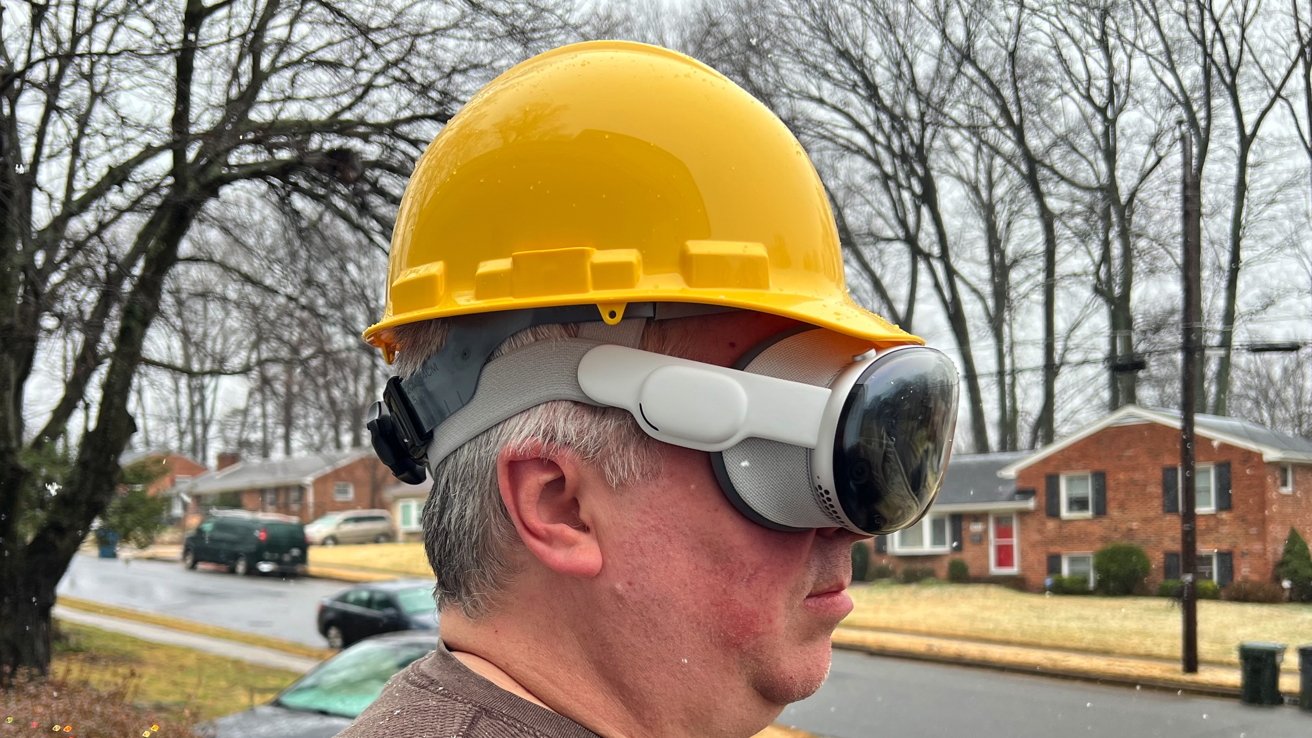
Your author in his new hard hat. Note the overhang, and proximity of the brim to the Digital Crown
And, given the inherent nature of the pass-through video, it's nearly impossible to do anything precise with it. The pass-through cameras are excellent compared to the competition, but depth while wearing it is not mapped one-to-one versus with it off and is distorted some when you're not perfectly centered.
And, it's not a full field of view. We've measured it out to be about 100 degrees, and perhaps as many as 105. Apple is tight-lipped on this for some reason, and we aren't sure why.
In short, while wearing Apple Vision Pro, it's easy to miss a door knob, swing a hammer and miss a nail, and the like.
Don't drive any kind of industrial equipment or other vehicle while wearing Apple Vision Pro. Beyond it being very illegal, it's bad enough that you'll probably get hurt or damage property doing it, but you'll also take innocents down with you at the same time.
Glasshole phenomenon isn't really relevant for businesses
More than a decade ago, Google tried the Google Glass. Folks started wearing them in public, and they were, at best, derided and, at worst, assaulted.
This time around, there's less of that so far. Even so, this doesn't matter a great deal to business and trades. If you need it for work, it doesn't matter so much how dumb or slick it may look while you're using it.
So, you might feel like you look dumb working with it on, but that isn't really being considered by your co-workers who are in the same boat. Your customers may think differently about that, but that's not particularly relevant.
Those snickering customers may eventually realize that the Apple Vision Pro is the face-mounted equivalent of technical manuals at some point. The TikTok-using public generating those mostly faked Apple Vision Pro in public clips paired with ten years of ubiquitous smartphone use since the Google Glass launch are breaking down some of the stigmas associated with headset use in the wild.
visionOS will be good for multi-user simulations -- eventually
What it is potentially good for is simulations. The same folks that provide the Apple Vision Pro to me over the summer of 2023 are evaluating it for their training efforts.
The simulation that they showed me six months ago has evolved, and is now a bit better with all the trainees sharing a virtual system in an open space -- a "set" to borrow a phrase from the training documentation and Hollywood.
Occlusion by the model works very well now, in good lighting, where it didn't before. Response time by the shared system reacting to what any given student or instructor is doing is excellent.
The virtual nature of the "set" still doesn't preclude a trainee from walking through the mechanics of the system, where they (obviously) couldn't in the real world.
An alternative is a dummy physical system built with virtual operation in mind. An early prototype we saw had an ersatz system built with actual mechanical components, manually operated valves, and gauges -- but no fluid, lubrication, or electricity flowing through the system beyond the bare minimum of what's needed for the simulation.
The Apple Vision Pro hardware just isn't that good at dealing with a hybrid system right now, though. In short, you can't set trainees loose in a warehouse with a built conveyor belt, for instance, and have them operate it without issues -- and it's not clear when this will change.
"The software is good, the cameras are better than we've used to try this kind of thing with other headsets," we were told by an official associated with the testing and training. "It's still not quite there, and somebody could get hurt cracking their hands on a valve hand wheel, or punching a panel accidentally, or something like that."
What they do like is the hand-tracking. So far, it's the best they've seen, and is precise enough now to do what they want in a well-lit space.
While I observed the simulation in virtual space, the operator's hands were always in range of the sensors, and the responsiveness of the system was excellent. The pass-through transmission to an iPad feature was also smooth, and facilitated user training and direction very well.
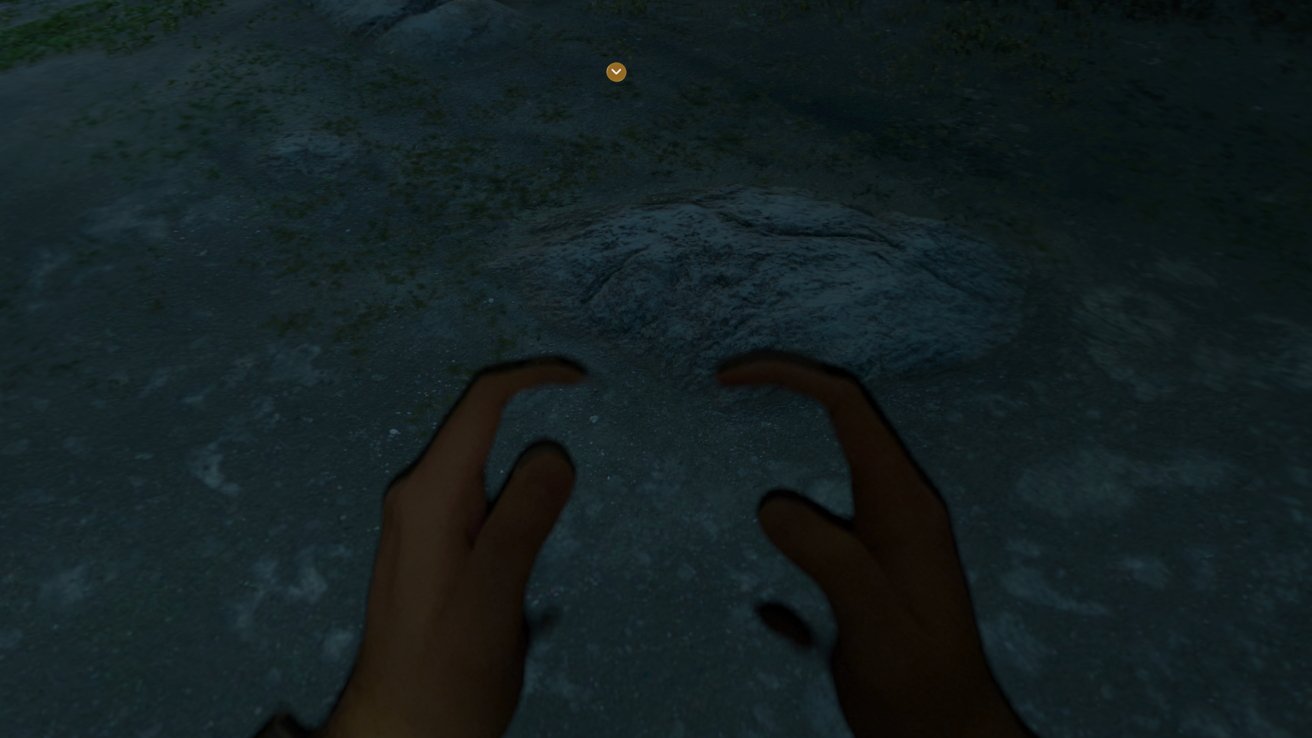 Apple Vision Pro for business review - it's a little disorienting not being able to see the controller
Apple Vision Pro for business review - it's a little disorienting not being able to see the controller
And in the simulation, there are two sources of audio -- the simulation room as a whole, and the Spatial Audio in the headset. General plant noise is piped into the room, with crisis noises like public announcements, fire noises, or rushing gases or water sounds added to that feed.
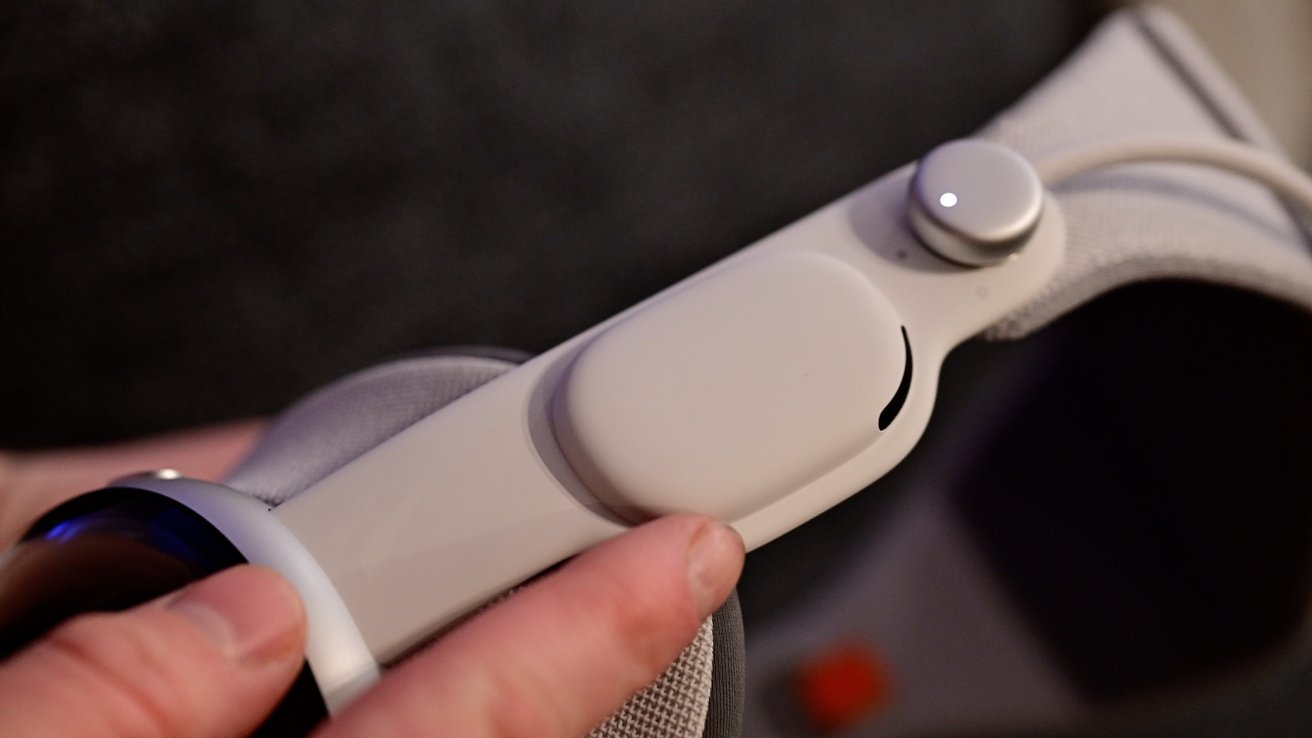
Apple Vision Pro review for business: Spatial audio speaker
More specific Spatial Audio as it pertains to specific and local operations are sent to a trainee's headset. And, communication is made directly with the student to the headset as well, so as to not interrupt the entire training environment.
All told, the experience as presented to me all three times I've been privileged to witness it was very slick. It's rough around the edges versus actual environment operation and the technical seams in the simulator are apparent.
It's better than what they used before Apple Vision Pro, though. It's also not what was promised to them in WWDC briefings and use time.
What it is, is a bid for the future of training in this particular industrial environment, and it's getting closer.
The Steve Jobs and Apple Vision Pro connection
We've heard it a lot -- "Steve Jobs would never" as it pertains to Apple Vision Pro. For the most part, arguments that invoke what Jobs would or would not have done, are logically fallacious, with the sayer trying to prove with an irrelevant Jobs story, whatever they want proven.
Jobs did talk headsets, to Walt Mossberg. And, he wasn't down on the entire concept -- just negative on the technology almost 19 years ago.
It is a giant mistake to use Jobs' words as some kind of eternal paradigm for technology, forever. The guy died over 12 years ago, and his opinions were formed and expressed given the technology of the day informed by about four years of Apple's roadmap at the time.
Most importantly, technology marches on, and so do the mindsets of the creators and public.
For example, Jobs famously didn't like tablets, until he did. He burned clean suits in advertising mocking Intel, until its technology was needed in the Mac just a few years after that ad campaign ran.
Jobs didn't say that Apple would never, ever make a headset, and Tim Cook has been positive on the technology as a whole since 2016. All Jobs said, 19 years ago, was that the available technology wasn't there yet.
This statement by Jobs was made just two years before Apple filed for a patent that looked very much like the Apple Vision Pro on the outside. He knew then that Apple had it on the roadmap in the distant future.
There were digital music players before the iPod, and Apple didn't make one until they thought the technology was there. The same goes for iPhone, iPad, Apple Watch.
And now, the same applies to Apple Vision Pro. Apple thinks the technology is here -- or close enough to get started the way that they want to do it.
Early days for Apple Vision Pro
There is always the argument to make that the first version of an Apple product should be avoided by most until there's refinement. The Apple Vision Pro is no exception.
The big business and government members we spoke to think it won't take just one iteration to hit that sweet spot, and wide market acceptance. Facebook/Meta hasn't been able to convince them to buy mass quantities of their headsets, and while there is a certain Apple cachet now, they aren't being convinced to buy this time around either.
The path ahead for Apple Vision Pro isn't completely obscured, but it is foggy. The first product out of the gate being "Pro" suggests that a non-pro version is coming at some point, and it's clear that Apple eventually wants something less bulky that can be more ubiquitous.
Sure, folks are wearing Apple Vision Pro while going about their day right now, but other than a few notable exceptions, they're performative and being done for the social media cred.
I've said it before, and the folks in business that we've spoken to agree with me -- the Apple Vision Pro as it stands in early 2024 is a developer kit that it spread far and wide and is about the most Apple product possible. Its ultimate adoption percentage will be very low, for several years to come, and even perhaps past that.
Apple Vision Pro is a glimpse at the future, but not practical for today
Overall, the concept and, well, long-term vision for Apple Vision Pro appear sound. The hardware is well-executed.
It's just a homeless product beyond media consumption right now, and probably will be for several more years.
The devout want it now, which is fine. It's good for Apple, and presumably good for the enthusiastic early adopter crowd.
What those adopters get is a marginal improvement over the shared experience that is a large television at home for an equivalent cost. On top of that, they get a good and private viewing experience on the go when travel mode works well -- which I'm confident it will do in time.
However, it's not a viable product for most businesses today. Enterprise doesn't want it right now because nothing they do is made better by it. There's some interest by the feds, but the form factor is still limiting.
The nature of optics slightly distorts the pass-through video, so, beyond the hard hat protrusion we discussed, it's maybe the hardest sell to trade workers.
So, for now, it's best for low-impact training, in a shared environment, but still not fabulous. The tools to develop that kind of thing for Apple Vision Pro aren't quite up to the promises that Apple made at WWDC 2023.
Maybe they will be for visionOS 2.0, but realistically, probably visionOS 4.0 or later. Today, right now, there's nothing it makes better for business, government, defense, or trade work.
After I appeared on the AppleInsider Podcast discussing this, critics of my opinion pointed to the iPhone, iPad, and Apple Watch as products that were similarly homeless at launch. However, all of those products were well-defined and had use cases and positive public mindshare as a product class when they shipped.
There were mobile phones in easily pocketable forms for a decade before iPhone. There were tablet-form computers for nearly a decade before iPad, and smart watches existed for a few years before Apple Watch.
And, in every case, there were positive examples in popular media of all three decades before.
Apple Vision Pro isn't doomed, and it isn't the downfall of Apple. Anybody trying to tell you that Steve Jobs would have crapped on it don't have any idea what the man would have liked or not, and completely missed that he set the table for the possibility almost two decades ago.
Yes, it is a new product that isn't well-defined. That's okay, though, because, like I've said before, Apple has the cash to wait it out, and they'll do that like they did the "hobby" Apple TV hardware.
Today, businesses and the federal government see utility in literally every other product lines Apple sells. They've seen this utility in the first year of an Apple product since around 2009 when they discovered that Apple wasn't doomed.
This year, this product, is different.
How long the Apple devout will need to keep that flag off the ground before the pole grabs enough traction in the VR sand to stay up on its own is another matter, though.
Read on AppleInsider


Comments
This represents a huge opportunity for 3rd party app developers. Also for apple's development team as well.
I'm certain the experience will improve over coming months and years.
Yes, the AVP is correctly likened to the iPhone, it is in essence the v1 iPhone.
iPhone replaced the iPod, but at its core it was a fully fledged, osx touting, wearable computer.
AVP is interesting, it is the iPhone, it is your monitor/screen/iPad. AND it is a fully fledged Mac… The cpu is the same as is on their laptops.
IF I was in industry, developing internal software/hardware, I would very much look to grab a full team of experienced game developers for UX development now… I would build a team that can program and make 3d visual systems that integrates with hardware. THAT is where AVP shines. It can interface with production equipment in an unprecedented way.
A production line that has realtime visualization of internal components? That can follow every product along the line, think a car… If you use AVP properly, there is a possibility for a manufacturing revolution.
TSMC is ahead of the US because there is expertize along all vectors of production, AVP could bridge the gap… Make a worker with less skill, skilled faster, and an expert when deployed. It is a way around the skill-gap. Or CAN be.
It can be a revolution for repairability, if a transistor blows, the board can show where the fault lies.
Apple is marketing this thing kind of in a "cart before the horse way" Pushing the truth as it were, with "spatial computing" before it is apparent. Steve Jobs pushed the fact that it is an iPod, a phone and an internet communicator. Which is enough.
Apple needs to push the actual benefits, it is an IMAX screen in your goggles, it is a stereoscopic camera for capturing your memories. AND it is the most powerful VR game machine.
Fully fledged spatial computer is the underlying fact, and people who see the value in that will pick it up.
Regardless, I wouldn’t expect much if any professional/industry early adoption of a brand new first-generation device. There hasn’t even been time for the app developers to explore it. But like other Apple devices, they will iterate and polish and use cases will be honed.
I know for sure that spatial videos are superior for instruction, if the 3d can be actual 3d, which it can. Either frame by frame equivalent 3d capture, or rigged 3d. The amount of detail available to understand instruction is infinitely higher. Especially when you can pause and look at the capture in detail. Invaluable.
I will be looking into making apps for instruction.
i bet it’s about five years when the use cases will be really compelling and sales start to take off. Kind of like the five years from the original Mac to the arrival of the LC and IIsi.
I view it positively. I think it’s exciting to see a radically new product category being born. I look forward to possibly buying one in five years (my first Mac was the IIsi).
Apple might well move on from this type of design within a generation or two, abandon it entirely for something more appropriate for mobile use, or completely surprise us with something we've not yet envisioned.
AppleInsider is not wrong about the limitations of THIS version, and the reasons those limitations won't be solved for the current AVP.
In general, it seems to be perceived by actual purchasers as an appropriate personal entertainment device if allowing for some discomfort, but not having much, if any, benefit over existing solutions for productivity purposes.
The VP would work very well for the interface to the ground station network hardware, and better than that, the VP is mobile enough to transfer into and out of vehicles to be used by a passenger.
Myself, I await Autodesk, SolidWorks, et al, to create connections to MCAD software.